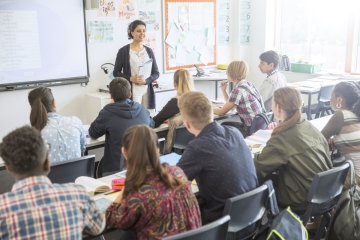I recently visited United Preparatory Academy (UPrep). It’s a charter school serving students in grades K-4 (growing to grade five) located in Franklinton—one of Columbus’s poorest neighborhoods, where the median household income is thirty percent lower than the city-wide average. About half the population has less than a high school diploma, and just one in ten have earned a four-year college degree. I say all this not to reduce the neighborhood, its families, or its children to these data points—but because from a research point of view, it makes what I’m about to tell you all the more powerful.
Before the visit started, I sat in the office alongside children who’d been dropped off wearing a random assortment of clothes other than the school uniform. It became apparent that it was a struggle for some families to keep freshly laundered clothes in stock for their children. This challenge is part of a growing conversation about how high-poverty schools go beyond the classroom in order to serve families, and more specifically, curb truancy. About ten kids waited while the office manager reached into a cabinet filled with black dress pants and bright blue, logoed polo shirts. One by one, he held up clothes next to each kid, approximated what might fit (few kids knew their own sizes), then sent them into a nearby restroom to change.
Each child emerged in crisp, clean uniforms, a few with pants needing to be rolled up or shoes to be tied, a few mentioning they had had growling bellies. They went off to their classrooms for breakfast, homework checks, and morning routines while the office manager assessed the clothing supply for that week and noted that it was hard to keep certain sizes in stock.
No matter how often I discuss the statistics, describing a school as “100 percent economically disadvantaged” in the context of research, my perspective changes each time I see its day-to-day impact in person. I take for granted my in-home access to a washer and dryer, even grumbling occasionally about having to do more and more laundry as my children grow. It was a disconnect that I hadn’t fully grasped until that very moment at 8:30 on a random Monday morning after having dropped off my own daughter at school (in uniform).
But this is just part of the story: UPrep’s students are poor, yes. But their academic performance is nothing short of outstanding, even as the school draws in one-third less funding than its traditional public school counterparts.
Not only does UPrep care for the basic needs of their students—things like providing proper school attire or hot breakfasts—they also keep their focus on the basic purpose of school: challenging their students to reach high academic goals.
Because of these efforts, and no doubt because of students’ innate drive to learn and to thrive, they’re knocking it out of the park. The school’s students are passing the state’s third-grade reading guarantee—a measure to ensure that youngsters are reading proficiently before promotion into the fourth grade—at a higher rate than my zoned neighborhood school in Clintonville, one with mixed incomes but also half-a-million dollar homes. Even more impressive is that UPrep third-graders scored accelerated and advanced on state exams at a rate that exceeded the state average and more than doubled that of Columbus City Schools. The table below shows that over half of UPrep third-graders met these lofty achievement levels.
Percent of third-graders reaching accelerated & advanced levels of proficiency (2016-17)
[[{"fid":"119389","view_mode":"default","fields":{"format":"default"},"link_text":null,"type":"media","field_deltas":{"1":{"format":"default"}},"attributes":{"class":"media-element file-default","data-delta":"1"}}]]
What UPrep and its charter network (United Schools Network) are doing is closing achievement gaps—those insidious, long-standing differences in performance between black, brown, and poor children and their wealthier, white peers. Teachers are putting in the gruelingly hard work of educating students who come to them academically behind while also caring deeply about their non-academic needs. Simply put, it’s not an either/or situation: Schools can, and should, do both.
Remember this the next time you hear someone say that Ohio’s expectations regarding third-grade reading are unreasonable, or each time well-intentioned leaders or school administrators try to lower the bar despite knowing full well that the ability to read effectively by third grade is highly predictive of later life success.
Be wary any time you overhear a neighbor, or god-forbid a public school teacher, raise the question, “how can we expect ‘these’ children to be reading at that level by that age?” or suggest that social promotion is the most compassionate option. If they don’t believe their own darling children are capable of so little, you’re looking straight in the face of “the soft bigotry of low expectations.”
Excellent schools can and do make a difference for children in poverty. Schools like UPrep remind us just how capable all children are of learning to high levels when we believe that they are and we do everything in our power to support them.



